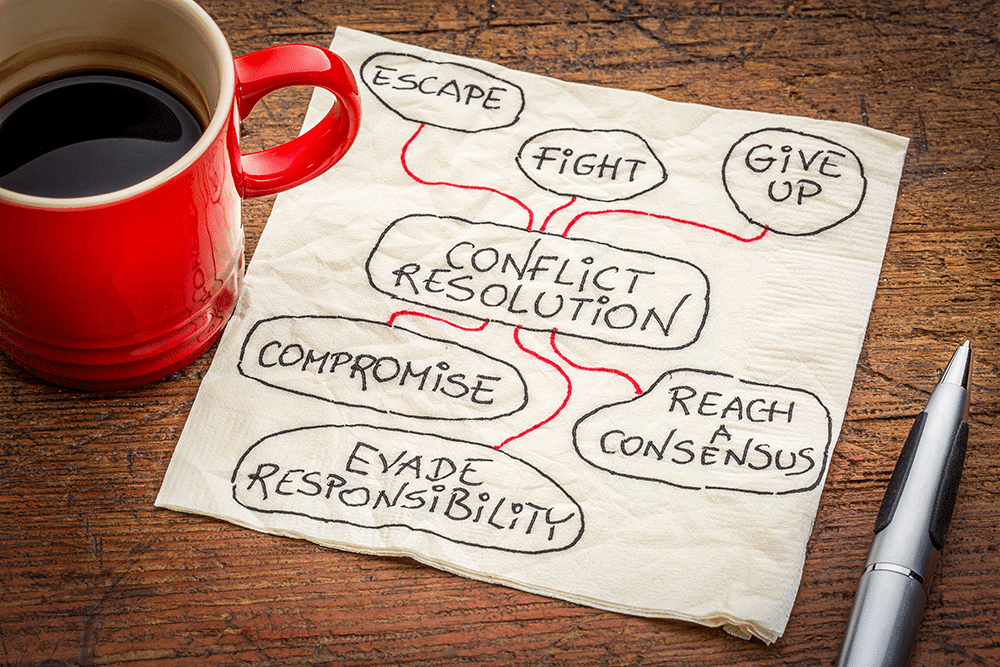
A tip of my hat to my sister for this month’s inspiration. I’ll call her Kevina to protect her real identity, but she’s not going to read this anyway.
You might be surprised to know my sister can be quite direct and is unafraid to offer her perspective to those whom she believes could benefit from her wisdom. Especially in the workplace.
Or if you know me, you might not be that surprised.
Those qualities haven’t always endeared her to the boss and her peers. And lately (only the last 45 years or so) there have been some conflicts with some peers, and she’s unhappy with senior leadership’s conflict resolution style. In my humble opinion, there hasn’t been any actual conflict resolution and damn little leadership – if any.
I won’t address her conflict resolution style. We’re working on that.
Conflict resolution isn’t fun, but it is a critical leadership skill. Managers hide behind policies and processes to punish perceived inappropriate behaviors between offended parties, but leaders know that failing to resolve conflicts leads to an increasingly toxic work environment, lower morale, higher attrition, reduced productivity, etc. Unfortunately, most leaders don’t get much practice because they don’t want to… it’s so much easier to let HR deal with personnel issues.
But there’s a simple three-step model we can employ for resolving conflict in the workplace – and everywhere else you live, play, worship, and shop for groceries. It works best when both sides benefit, but you can’t always control the outcome, only the process. Not often easy, but simple.
And it might take more time than you want, but if you’re in a leadership position, nothing is more important than taking the time necessary to create a positive work environment where people feel appreciated doing worthy work. Relationship repair isn’t just for therapists.
First step: take all the time it takes to get the facts and issues on the table. That means you have to talk to people individually and together. Unless, of course, you’re the one who’s involved in the conflict, and then you’re going to have to bite the bullet and talk face-to-face with the other person.
The reason I emphasize all is it’s easy to jump to a conclusion that makes it appear you have a bias. Then you’re a part of the conflict whether you want to be or not.
No one gets their own facts! When we focus on what’s right and not who’s right, we might discover it’s just a communication issue (everyone gets their own perception) and not an actual conflict. From the outside looking in, it’s often easy to see how preconceived notions have contributed to the mess we’re dealing with.
In Kevina’s case, one of the complaints is that she always looks angry when she talks to her cohorts. Kevina claims it’s not her fault she had RBF – Resting Bitch Face. And she was accused of only hugging old women at work; she claims she gives hugs to people who seem to need them out of compassion and old women (like her) seem to need them more than others.
Okay, you get the picture. I could fill your day with stories of how Kevina is always being targeted and accused of inappropriate behavior only to have a perfectly reasonable explanation. This crap could have been stopped years ago, but senior management (not leadership) has only dealt with it individually and secretly, so it continues to fester.
Second step: seek to understand both points of view. And then help those involved in the conflict to understand the other point of view, so they can understand what it is the other person needs out of the resolution. Not what they want, but what they need.
I’m not a therapist, but sometimes it helps to remind people what they can control and what they can’t. They can’t control other people’s thoughts, feelings, actions, or mistakes. They can, however, control how they respond to them (albeit not very well sometimes).
Now’s probably a good time to take a break. Not reading this, but time to think about the third step.
Third step: find a win/win solution. And unless you’re blessed with an intuitive skill that makes you a peacemaker, this is the part of leadership that takes practice. Be hard on the problem, not the person.
It’s not a sign of weakness to talk it over with a trusted third party or an executive coach; it’s an indication that you care enough about the resolution enough to do the best thing – for the people and the company. Like I said, leaders typically don’t like to get into the conflict resolution arena, so the skills don’t get honed as often as they probably should.
Resolutions don’t have to be a zero-sum exchange or a give-and-take. See them as a positive-sum exchange where both sides benefit by getting what they need.
That’s it: get all the facts and issues on the table, seek to understand both points of view, and find a win/win solution. I told you it was simple.
And please, don’t hide from the conflict like Kevina’s leadership has. I can only predict that someone is going to be out of a job before this is all over.
But that’s up to you, leaders.

